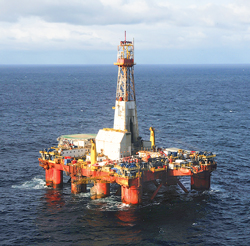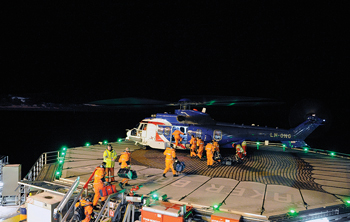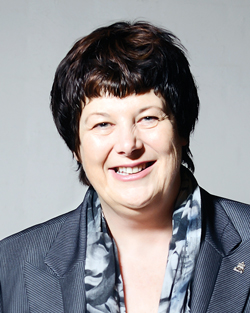 |
| Norway is looking to leverage a mix of technology and planning in new discoveries, like the North Sea's Johan Sverdrup development, to supplement declining production from existing fields (photo credit: Harald Pettersen/Statoil). |
|
World Oil: What are the NPD’s main objectives and responsibilities, with regard to Norwegian offshore development?
Bente Nyland: The main basis on which we operate is to maximize the benefits of oil and gas for Norway, in general. Then there are four more specific goals, identified by the government: to encourage exploration of new areas; to promote further exploration of acreage that is already open; to enable the development of new discoveries; and to ensure that recovery is increased from existing resources. We need to work on all these aspects to keep oil and gas activity on track in Norway.
WO: Extending the life of existing fields, through techniques such as increased oil recovery (IOR), is a hot topic across the North Sea. What success has there been in the Norwegian offshore?
Nyland: It is a priority, in the short term, to work continuously to get more out of the resources we already know are there. Happily, we have been able to extend the production period of several big fields developed in the 1980s and 1990s. In fact, even Ekofisk, which was first developed in the early 1970s, is still onstream.
Ekofisk had an expected recovery rate of 17% to 18%, when production first started. Now, it is heading for 55%.
WO: Is getting the most out of existing fields the most pressing issue?
Nyland: Yes, because there is a shorter time limit. Some of these fields are at the tail end of their lives, so the cost per barrel is increasing. You come to a point, where you have to invest in EOR, or production will become too expensive and simply stop. Then it will be too late. So, the question is judging the right moment to start investing, to prolong field life.
WO: Is Norway taking a lead on IOR?
Nyland: I think we are in the lead, globally, on IOR. Companies are working on this all around the world, of course, but, talking to authorities in other countries, the focus does not seem to have been as strong as in Norway. Here, IOR from existing fields is even on the political agenda, and I haven't seen that in other places.
WO: What about new projects? What is NPD’s role there?
Nyland: One important aspect of NPD’s role is to check with the operator, when they are delivering their development plans, to ensure that they have looked, not only at how they are going to realize the potential from the field in question, but also that they have looked at the potential of any neighboring areas that it might be possible to tie back into the structure they are proposing.
We need to encourage companies to raise their eyes and look at those nearby areas—whether Company A on one field should be talking to Company B in a neighboring field, with a view of doing a more economically viable joint development. It makes sense, because it is cheaper to have one structure than two.
WO: Are there examples where this approach has reaped dividends?
Nyland: The operators of the Edvard Grieg and Ivar Aasen fields [Lundin and Det norske oljeselskap, respectively], and their partners, drew up their own development plans, but these were made conditional on cooperation for production. The oil from both will now be exported via one pipeline.
In deeper water, Statoil is coordinating the development of a number of small discoveries into the Aasta Hansteen field, where, conveniently, it is the license-holder for all of them. It plans to develop a hub there and achieve economies of scale from that.
WO: NPD is a more hands-on regulator than those in many other countries. What difference does that make?
Nyland: You probably saw that the Wood Review [into maximizing recovery on the UK Continental Shelf] drew attention to Norway’s effort, mentioning that it has been beneficial that NPD attends key operators’ meetings, and so understands the challenges facing companies better.
We have also been able to promote wider use of injection technologies and intelligent drilling. For example, Troll field in the North Sea was originally planned as just a gas development, because there was only a thin layer of oil, which was regarded as non-commercial. But NPD said that we wanted to check out whether the oil shown in the area could be developed—and, in the end, it proved to be possible using extended horizontal wells.
WO: How do you persuade firms to look at these propositions?
Nyland: We work hard at it and it’s important that NPD is staffed by people with backgrounds in engineering, geology and reservoir management. That means it is easier to have a dialogue with the companies. They know it will be very difficult to get approval for a development, if they haven’t considered all the possible solutions and economies and the use of technology. We want the industry to decide how best to do this. Troll is a very good example. From having been considered to be non-commercial in terms of oil, it became one of Norway’s most productive oil fields.
WO: So where are the next opportunities in Norway? How important is the Johan Sverdrup oil discovery, which has an estimated resource of up to around 3 billion bbl?
Nyland: There are a number of new discoveries that should start producing between 2015 and 2020. Johan Sverdrup will be very important, when it comes onstream around 2019, as it will help to fill the gap caused by the decline in production from existing fields. It will be a different story from the existing fields, because new fields can be developed to get the most from new technology and approaches.
WO: So, you remain confident that the Norwegian Continental Shelf still has a strong future, despite forecast declines in output?
Nyland: Absolutely. I think we’ve learned that you should never write off an area. The first license on the Norwegian shelf actually covered Johan Sverdrup, a number of wells have been drilled all around the field, but not in the middle. When they did drill in the middle, they found the fifth-largest field in Norway.
WO: How is Norway planning to develop more northerly areas, such as the Barents Sea?
Nyland: We had very high activity in the Barents Sea in the 1980s and 1990s, but development was put on hold, due to a lack of infrastructure. When LNG transport became possible, we were able to develop Snøhvit gas field. Apart from that, there were a lot of small discoveries, but none of them were commercial in isolation, and none of them could be tied to one hub installation. Goliat oil field will be the next to go onstream.
After an environmental assessment covering the Norwegian Sea and the Barents Sea was carried out, it became clear around 2008–2009 that drilling activity could still be carried out, and some new oil discoveries were made, such as Johan Castberg.
 |
| Overcoming transportation challenges will be critical to successfully develop oil and gas fields in the Barents Sea (photo credit: Harald Pettersen/Statoil). |
|
WO: Have technological advances driven this new phase of development?
Nyland: Improvements in seismic imaging were very important in improving prospectivity in the area. In the early days, the gas on top had disguised the seismic signature of the reflectors below. The quality of the seismic data is the alpha and omega. With Johan Castberg, once we had clearer data, Statoil could see there were good structures to drill.
WO: What about the well-known concerns over Arctic drilling? How is Norway addressing these?
Nyland: In the Norwegian Arctic, you are not talking about the same conditions as in the Canadian or Russian Arctic. We have an open sea, and ice is not a major problem with the areas opened for petroleum activity, so far. There are no plans at the moment to move further north than we already have.
I think the biggest issue is the distance from the shore to the outermost areas. There is a lack of infrastructure, and you are at the outer limits of helicopter transport, for example. There are some Arctic islands up there, but you cannot depend on these for logistics, so you need to look at what you can do from facilities in northern Norway. You will need longer-range helicopters or fueling stations en-route. The remoteness also means you need to be particularly careful about preparedness for an emergency response, if there is an accident, such as a spill.
Also, while oil is easier to develop and transport out of the area, if a lot of gas is found in the Barents Sea, ways will need to be found to transport it. We have an LNG plant, but its capacity is fully booked for years, so it will either need to be expanded, or enough resources will need to be found to justify building a pipeline.
WO: Are water depth issues and difficult drilling conditions a problem in the area?
Nyland: In the Barents Sea, the sea depth only goes down to around 300 m, and it’s not high-temperature/high-pressure [HTHP] drilling, so it’s relatively easy in that sense.
We do have some HTHP areas on the Norwegian Continental Shelf, where you are drilling 4,000 or 5,000 m down into the layers. But these issues are well known, so you can prepare for them and, when the ministry awards new licenses in these areas, the operators need to show competence in HTHP drilling. In the Barents Sea, we also have polar winter weather, when everything gets coated in ice. So it is a prerequisite that rigs in the Barents Sea must be “winterized,” so that they can handle those conditions.
WO: How does NPD see the outlook for Norwegian oil and gas production?
Nyland: In five years’ time, production from the Norwegian shelf will be around the same level as we have today. Oil production will flatten out, but may increase a little.
Today, around 50% of production from the Norwegian shelf is gas, and that has been increasing, partly because we have discovered more, but also because we are producing the gas from fields where the oil has been produced first.
After 2020, there may be a fall in the total oil and gas production, so we need to look for production from fields yet to be discovered. We still think there is a lot of oil and gas to find in the North Sea. It may be in small discoveries, but they should be economic, if they are near existing infrastructure.
When it comes to the Norwegian Sea, the deepwater areas haven’t been as successful as we had hoped. We are now analyzing why this has happened, and what further possibilities there may be in deepwater areas.
In the Barents Sea, there are hopes in the newly opened area toward the Russia sector. The Shtokman discovery was made on the Russian side. They have put that on hold for the time being, but we see some similar structures on the Norwegian side of the maritime boundary. It will be exciting to see whether this area holds new resources. 
|
 |
| BENTE NYLAND was appointed director general of the Norwegian Petroleum Directorate in 2007. She joined the directorate in 1984, as a senior geologist, and was appointed to her first management position in 1989, before becoming a member of the management team in 2000. She began her career as an exploration geologist at Statoil, where she worked for five years. Ms. Nyland has served on a number of boards, including those of the Norwegian Geotechnical Institute (NGI), the Norwegian Institute for Energy Technology (IFE), the University Fund for Rogaland and the University of Stavanger. |
|
|
|





